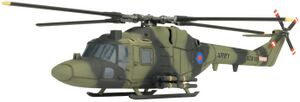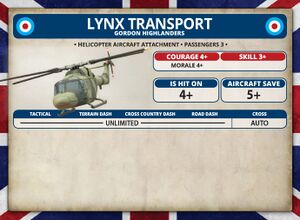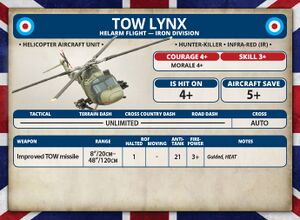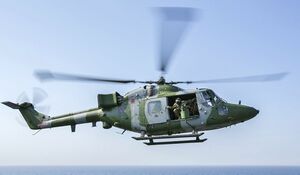Lynx Helicopter: Difference between revisions
1d4chan>Catnip212 |
imported>Administrator m 21 revisions imported |
||
| (19 intermediate revisions by 5 users not shown) | |||
| Line 1: | Line 1: | ||
[[File:Lynx.jpg|300px|right|thumb|The Lynx]] | [[File:Lynx.jpg|300px|right|thumb|The Lynx. A rather deceptive beast, to be honest.]] | ||
(For context: heliborne units refer to infantry forces which are transported by helicopter assets. Air Assault forces refer to units whose helicopters were capable of supporting the infantry while landing in combat zones. Airmobile forces refer to units whose helicopters could not be deployed into combat, and would use them as battle taxis. Airborne refers to deployment of vehicles and/or infantry via parachutes, NOT helicopters.) | (For context: heliborne units refer to infantry forces which are transported by helicopter assets. Air Assault forces refer to units whose helicopters were capable of supporting the infantry while landing in combat zones. Airmobile forces refer to units whose helicopters could not be deployed into combat, and would use them as battle taxis. Airborne refers to deployment of vehicles and/or infantry via parachutes, NOT helicopters.) | ||
Distinct from the US and Soviet Heliborne units, the British deployed airmobile units rather than air assault forces. From observations the Vietnam War, the Soviets and Americans designed helicopters which would deploy troops directly into the battle and featured a level of protection against small arms. | Distinct from the US and Soviet Heliborne units, the British deployed airmobile units rather than air assault forces. From observations of the Vietnam War, the Soviets and Americans designed helicopters which would deploy troops directly into the battle and featured a level of protection against small arms. The Soviets chose to develop the MI-24 Hind as a flying tank equipped with an autocannon, rocket pods and ATGM missiles despite this machine being used as a simple transport. Units which relied on Hinds include the 13 Air Assault brigades of the VDV, and the Polish 6th Pomeranian Air Assault Division. The US, meanwhile, separated their combat and transport helicopters with the transporting Blackhawk toting a pair of door-mounted 7.62mm machine guns. Certain air assault units in the 101st Airborne and the 160th SOAR had their Blackhawks equipped with miniguns, as they were expected to enter active drop zones with a light enemy presence, serving as a blocking force against reinforcements for a certain location or to attack lightly defended locations. | ||
For some absurd reason, the British failed to develop their helicopter tactics and were therefore stuck with the Lynx: an excellent combat helicopter but an incredibly poor choice for heliborne infantry, being more akin to the UH-1 Huey. While most <s>Hueys</s> and Lynx AH-1s were equipped with a 7.62mm machine gun, these are not represented in-game. | For some absurd reason, the British failed to develop their helicopter tactics and were therefore stuck with the Lynx: an excellent combat helicopter but an incredibly poor choice for heliborne infantry, being more akin to the UH-1 Huey. While most <s>Hueys</s> and Lynx AH-1s were equipped with a 7.62mm machine gun, these are not represented in-game. | ||
==Lynx AH-1 == | ==Lynx AH-1 == | ||
[[File:Lynx Card.jpg|300px|left|thumb|The Stat Card]] | [[File:Lynx Card.jpg|300px|left|thumb|The Stat Card]] | ||
===In Team Yankee=== | |||
The Lynx only comes with all airmobile rifle and Milan platoons, meaning that your company HQ has to share a lynx with the rest of <s>the lower classes</s> their brothers in arms. The use of these vehicles is straightforward for the most part: to transport troops into areas where your opponent would not like, such as their backline while using blitz orders to ensure that troops can get out immediately; blitzing to land, then blitzing the infantry out of the transport. After which, you may consider using them to block enemy movement, such as landing a lynx directly in front of a tank. Your sacrifice will be remembered. | |||
The Lynx only comes with all airmobile rifle and Milan platoons, meaning that your company HQ has to share a lynx with the rest of <s>the lower classes</s> their brothers in arms. The use of these vehicles is straightforward for the most part | |||
Unlike the Hind, the Lynx has a mediocre 5+ aircraft save, and so should not be expected to survive any dedicated anti-air fire. | Unlike the Hind, the Lynx has a mediocre 5+ aircraft save, and so should not be expected to survive any dedicated anti-air fire. | ||
===In Real Life=== | |||
The Lynx was adopted in 1978 into the British Army Air Corps. Originally a civilian utility helicopter, the design was created to carry heavy loads in a slim, maneuverable package. This made it an excellent choice for the role of a gunship; as its small frame made it well suited to shoot and scoot tactics (Hunter-Killer tactics are incorrectly referred to in Iron Maiden; the term refers to having a team with a member designating targets while another actually executes the kill). Other variants for reconnaissance are available. Some transport variants of the Lynx utilized rocket pods or 7.62mm machine guns to try and provide some fire support to the infantry as a last resort. The actual use of Lynxes as transport helicopters is most prominent in the Royal Marines who employ these vehicles when beachcraft would prove unsuitable. Their niche as fast, unarmoured transport helicopters also makes them a favorite with Special Forces like the Special Boat Service. | |||
If you wish to model a historical heliborne infantry list, the Gordon Highlanders are possibly the least suitable for the job due to their totally unrealistic armament. The Royal Marines and Paras would never carry Milans on such a scale, relying on air support and Carl Gustavs instead. | |||
The | The latest version is the AW159 Wildcat. Which will replace the previous versions of the Lynx. | ||
==Lynx AH-1 TOW == | ==Lynx AH-1 TOW == | ||
[[File:TB125.jpg|300px|right|thumb|The Stat Card]] | |||
===In Team Yankee=== | |||
The AH-1 TOW is the helicopter of the British, indicative of their attitude towards technology compared to the other factions. While the Americans and Soviets slapped their helicopters with armor and autocannons, the British were installing tea-boilers into all their vehicles. Lacking the rocket pods and autocannons of the Cobra or the transport capacity and armor of the Hind, the AH-1 TOW has a single role: destroying enemy tanks. The unit should be used in flanking to take advantage of its superior movement value to compensate for its mediocre AT value. Note that with this unit, you pay a premium for mobility, so use it well! | |||
At 6 points for a pair or 12 points for a 4 helicopter Flight, the AH-1 TOW is a niche choice for two main options: players seeking to exploit the unprotected flanks of their opponents or those seeking air-superiority. Due to the rules for anti-air, it is possible to use the AH-1 TOW to engage enemy anti-air platforms in a SEAD (Suppression of Enemy Air Defence) fashion. Since players must declare defensive fire before air units open fire, it is entirely possible to force the opponent to choose between engaging the Lynxes immediately or allowing a whole unit to be exposed to a full volley of ATGM fire, potentially leaving an area vulnerable to bombers. | |||
However, the AH-1 TOW remains a niche choice due to the sheer point cost. For the points, it is possible to simply purchase 12 Milans which would trade the mobility for thrice the firepower. If you insist on using them in this role, you may wish to switch to an American Aviation list instead (2-3 Cobra Platoons with Harriers). | |||
===In Real Life=== | |||
[[File:Lynx in the wild.jpg|right|300px|thumb|The Lynx in the wild]] | |||
While critics may highlight the lack of armor on the Lynx, it is crucial to note the differing roles between British and Soviet or American doctrine. While the two superpowers envisioned helicopter assaults which would make Wagner cream his pants, the ability of the Lynx to carry heavy loads while maintaining control at high speeds made it an excellent gunship, albeit a rather fragile one. Furthermore, the comparatively smaller British Army requires troops to be spent far more cautiously, with Air Assault units like the 101st and VDV requiring specialized (read: MOAR MONEH) training and equipment to be effective. The most common variation used today is the Lynx AH-7, used primarily as a missile carrier in the HELARM role. The use of weapon pylons also allows for the possibility of equipping the Lynx with autocannons, anti-air missiles or other equipment. | |||
{{British Forces in Team Yankee}} | {{British Forces in Team Yankee}} | ||
[[Category:Team Yankee]] | [[Category:Team Yankee]] | ||
[[Category:Vehicles]] | |||
Latest revision as of 17:18, 21 June 2023

(For context: heliborne units refer to infantry forces which are transported by helicopter assets. Air Assault forces refer to units whose helicopters were capable of supporting the infantry while landing in combat zones. Airmobile forces refer to units whose helicopters could not be deployed into combat, and would use them as battle taxis. Airborne refers to deployment of vehicles and/or infantry via parachutes, NOT helicopters.)
Distinct from the US and Soviet Heliborne units, the British deployed airmobile units rather than air assault forces. From observations of the Vietnam War, the Soviets and Americans designed helicopters which would deploy troops directly into the battle and featured a level of protection against small arms. The Soviets chose to develop the MI-24 Hind as a flying tank equipped with an autocannon, rocket pods and ATGM missiles despite this machine being used as a simple transport. Units which relied on Hinds include the 13 Air Assault brigades of the VDV, and the Polish 6th Pomeranian Air Assault Division. The US, meanwhile, separated their combat and transport helicopters with the transporting Blackhawk toting a pair of door-mounted 7.62mm machine guns. Certain air assault units in the 101st Airborne and the 160th SOAR had their Blackhawks equipped with miniguns, as they were expected to enter active drop zones with a light enemy presence, serving as a blocking force against reinforcements for a certain location or to attack lightly defended locations.
For some absurd reason, the British failed to develop their helicopter tactics and were therefore stuck with the Lynx: an excellent combat helicopter but an incredibly poor choice for heliborne infantry, being more akin to the UH-1 Huey. While most Hueys and Lynx AH-1s were equipped with a 7.62mm machine gun, these are not represented in-game.
Lynx AH-1[edit | edit source]

In Team Yankee[edit | edit source]
The Lynx only comes with all airmobile rifle and Milan platoons, meaning that your company HQ has to share a lynx with the rest of the lower classes their brothers in arms. The use of these vehicles is straightforward for the most part: to transport troops into areas where your opponent would not like, such as their backline while using blitz orders to ensure that troops can get out immediately; blitzing to land, then blitzing the infantry out of the transport. After which, you may consider using them to block enemy movement, such as landing a lynx directly in front of a tank. Your sacrifice will be remembered.
Unlike the Hind, the Lynx has a mediocre 5+ aircraft save, and so should not be expected to survive any dedicated anti-air fire.
In Real Life[edit | edit source]
The Lynx was adopted in 1978 into the British Army Air Corps. Originally a civilian utility helicopter, the design was created to carry heavy loads in a slim, maneuverable package. This made it an excellent choice for the role of a gunship; as its small frame made it well suited to shoot and scoot tactics (Hunter-Killer tactics are incorrectly referred to in Iron Maiden; the term refers to having a team with a member designating targets while another actually executes the kill). Other variants for reconnaissance are available. Some transport variants of the Lynx utilized rocket pods or 7.62mm machine guns to try and provide some fire support to the infantry as a last resort. The actual use of Lynxes as transport helicopters is most prominent in the Royal Marines who employ these vehicles when beachcraft would prove unsuitable. Their niche as fast, unarmoured transport helicopters also makes them a favorite with Special Forces like the Special Boat Service.
If you wish to model a historical heliborne infantry list, the Gordon Highlanders are possibly the least suitable for the job due to their totally unrealistic armament. The Royal Marines and Paras would never carry Milans on such a scale, relying on air support and Carl Gustavs instead.
The latest version is the AW159 Wildcat. Which will replace the previous versions of the Lynx.
Lynx AH-1 TOW[edit | edit source]

In Team Yankee[edit | edit source]
The AH-1 TOW is the helicopter of the British, indicative of their attitude towards technology compared to the other factions. While the Americans and Soviets slapped their helicopters with armor and autocannons, the British were installing tea-boilers into all their vehicles. Lacking the rocket pods and autocannons of the Cobra or the transport capacity and armor of the Hind, the AH-1 TOW has a single role: destroying enemy tanks. The unit should be used in flanking to take advantage of its superior movement value to compensate for its mediocre AT value. Note that with this unit, you pay a premium for mobility, so use it well!
At 6 points for a pair or 12 points for a 4 helicopter Flight, the AH-1 TOW is a niche choice for two main options: players seeking to exploit the unprotected flanks of their opponents or those seeking air-superiority. Due to the rules for anti-air, it is possible to use the AH-1 TOW to engage enemy anti-air platforms in a SEAD (Suppression of Enemy Air Defence) fashion. Since players must declare defensive fire before air units open fire, it is entirely possible to force the opponent to choose between engaging the Lynxes immediately or allowing a whole unit to be exposed to a full volley of ATGM fire, potentially leaving an area vulnerable to bombers.
However, the AH-1 TOW remains a niche choice due to the sheer point cost. For the points, it is possible to simply purchase 12 Milans which would trade the mobility for thrice the firepower. If you insist on using them in this role, you may wish to switch to an American Aviation list instead (2-3 Cobra Platoons with Harriers).
In Real Life[edit | edit source]

While critics may highlight the lack of armor on the Lynx, it is crucial to note the differing roles between British and Soviet or American doctrine. While the two superpowers envisioned helicopter assaults which would make Wagner cream his pants, the ability of the Lynx to carry heavy loads while maintaining control at high speeds made it an excellent gunship, albeit a rather fragile one. Furthermore, the comparatively smaller British Army requires troops to be spent far more cautiously, with Air Assault units like the 101st and VDV requiring specialized (read: MOAR MONEH) training and equipment to be effective. The most common variation used today is the Lynx AH-7, used primarily as a missile carrier in the HELARM role. The use of weapon pylons also allows for the possibility of equipping the Lynx with autocannons, anti-air missiles or other equipment.
| British Forces in Team Yankee | |
|---|---|
| Tanks: | Chieftain - Challenger 1 |
| Transports: | Spartan Transport - FV432 Transport - FV510 Warrior - Lynx Transport |
| Infantry: | Mechanized Company - Milan Section (Mechanized) - Airmobile Company - Milan Platoon (Airmobile) - Support Troop |
| Artillery: | Abbot Field Battery - M109 Field Battery - FV432 Mortar Carrier -M270 MLRS |
| Anti-Aircraft: | Spartan Blowpipe - Tracked Rapier - Chieftain Marksman |
| Tank Hunters: | Striker - Spartan MCT - Swingfire |
| Recon: | FV432 FOO - Scorpion - Scimitar -FV721 Fox |
| Aircraft: | Harrier Jump Jet - Lynx HELARM |